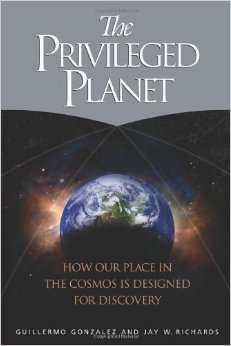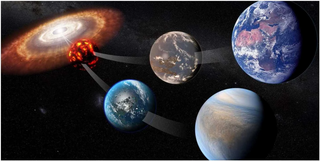
Astrobiology is a scientific field within the life and environmental sciences that studies the origins, early evolution, distribution, and future of life in the universe by investigating its deterministic conditions and contingent events. As a discipline, astrobiology is founded on the premise that life may exist beyond Earth.

The Drake equation is a probabilistic argument used to estimate the number of active, communicative extraterrestrial civilizations in the Milky Way Galaxy.

Extraterrestrial life or alien life is life which does not originate from Earth. No extraterrestrial life has yet been conclusively detected. Such life might range from simple forms such as prokaryotes to intelligent beings, possibly bringing forth civilizations that might be far more advanced than humanity. The Drake equation speculates about the existence of sapient life elsewhere in the universe. The science of extraterrestrial life is known as astrobiology.
The Fermi paradox is the discrepancy between the lack of conclusive evidence of advanced extraterrestrial life and the apparently high likelihood of its existence. As a 2015 article put it, "If life is so easy, someone from somewhere must have come calling by now."

In planetary astronomy and astrobiology, the Rare Earth hypothesis argues that the origin of life and the evolution of biological complexity such as sexually reproducing, multicellular organisms on Earth required an improbable combination of astrophysical and geological events and circumstances.

In astronomy and astrobiology, the habitable zone (HZ), or more precisely the circumstellar habitable zone (CHZ), is the range of orbits around a star within which a planetary surface can support liquid water given sufficient atmospheric pressure. The bounds of the HZ are based on Earth's position in the Solar System and the amount of radiant energy it receives from the Sun. Due to the importance of liquid water to Earth's biosphere, the nature of the HZ and the objects within it may be instrumental in determining the scope and distribution of planets capable of supporting Earth-like extraterrestrial life and intelligence.
The Great Filter is the idea that in the development of life from the earliest stages of abiogenesis to reaching the highest levels of development on the Kardashev scale, there is a barrier to development that makes detectable extraterrestrial life exceedingly rare. The Great Filter is one possible resolution of the Fermi paradox.

Planetary habitability is the measure of a planet's or a natural satellite's potential to develop and maintain environments hospitable to life. Life may be generated directly on a planet or satellite endogenously or be transferred to it from another body, through a hypothetical process known as panspermia. Environments do not need to contain life to be considered habitable nor are accepted habitable zones (HZ) the only areas in which life might arise.
Peter Douglas Ward is an American paleontologist and professor at the University of Washington, Seattle, and Sprigg Institute of Geobiology at the University of Adelaide. He has written numerous popular science works for a general audience and is also an adviser to the Microbes Mind Forum. In 2000, along with his co-author Donald E. Brownlee, he co-originated the term Rare Earth and developed the Medea hypothesis alleging that multicellular life is ultimately self-destructive.

The Privileged Planet: How Our Place in the Cosmos is Designed for Discovery is a 2004 book by Guillermo Gonzalez and Jay Richards, in which the authors claim scientific evidence for intelligent design. Both Gonzalez and Richards are associated with the Discovery Institute, identified with the intelligent design movement; Gonzalez works as a senior fellow of the Discovery Institute's Center for Science and Culture.
Guillermo Gonzalez is an astronomer, a proponent of the pseudoscientific principle of intelligent design, and a research scientist at the University of Alabama-Huntsville. He is a senior fellow of the Discovery Institute's Center for Science and Culture, considered the hub of the intelligent design movement, and a fellow with the International Society for Complexity, Information and Design, which also promotes intelligent design.
James Fraser Kasting is an American geoscientist and Distinguished Professor of Geosciences at Penn State University. Kasting is active in NASA's search for habitable extrasolar planets. He is considered a world leader in the field of planetary habitability, assessing habitable zones around stars. He was elected a member of the National Academy of Sciences in 2018. Kasting also serves on the Advisory Council of METI.

Neocatastrophism is the hypothesis that life-exterminating events such as gamma-ray bursts have acted as a galactic regulation mechanism in the Milky Way upon the emergence of complex life in its habitable zone. It is one of several proposed solutions to the Fermi paradox since it provides a mechanism which would have delayed the advent of intelligent beings in local galaxies near Earth.
Donald Eugene Brownlee is a professor of astronomy at the University of Washington at Seattle and the principal investigator for NASA's Stardust mission. In 2000, along with his co-author Peter Ward, he co-originated the term Rare Earth, in reference to the possible scarcity of life elsewhere in the universe. His primary research interests include astrobiology, comets, and cosmic dust. He was born in Las Vegas, Nevada.

An Earth analog, also called an Earth analogue, Earth twin, or second Earth, is a planet or moon with environmental conditions similar to those found on Earth. The term Earth-like planet is also used, but this term may refer to any terrestrial planet.

In astrobiology and planetary astrophysics, the galactic habitable zone is the region of a galaxy in which life might most likely develop. The concept of a galactic habitable zone analyzes various factors, such as metallicity and the rate and density of major catastrophes such as supernovae, and uses these to calculate which regions of a galaxy are more likely to form terrestrial planets, initially develop simple life, and provide a suitable environment for this life to evolve and advance. According to research published in August 2015, very large galaxies may favor the birth and development of habitable planets more than smaller galaxies such as the Milky Way. In the case of the Milky Way, its galactic habitable zone is commonly believed to be an annulus with an outer radius of about 10 kiloparsecs (33,000 ly) and an inner radius close to the Galactic Center.
The Virtual Planetary Laboratory (VPL) is a virtual institute based at the University of Washington that studies how to detect exoplanetary habitability and their potential biosignatures. First formed in 2001, the VPL is part of the NASA Astrobiology Institute (NAI) and connects more than fifty researchers at twenty institutions together in an interdisciplinary effort. VPL is also part of the Nexus for Exoplanet System Science (NExSS) network, with principal investigator Victoria Meadows leading the NExSS VPL team.

A superhabitable planet is a hypothetical type of exoplanet or exomoon that may be better suited than Earth for the emergence and evolution of life. The concept was introduced in 2014 by René Heller and John Armstrong, who have criticized the language used in the search for habitable planets and proposed clarifications. According to Heller and Armstrong, knowing whether or not a planet is in its host star's habitable zone (HZ) is insufficient to determine its habitability: It is not clear why Earth should offer the most suitable physicochemical parameters to living organisms, as "planets could be non-Earth-like, yet offer more suitable conditions for the emergence and evolution of life than Earth did or does." While still assuming that life requires water, they hypothesize that Earth may not represent the optimal planetary habitability conditions for maximum biodiversity; in other words, they define a superhabitable world as a terrestrial planet or moon that could support more diverse flora and fauna than there are on Earth, as it would empirically show that its environment is more hospitable to life.

The following outline is provided as an overview of and topical guide to extraterrestrial life:

The Life and Death of Planet Earth is a popular science book by paleontologist Peter Ward and astronomer Donald E. Brownlee. Released in 2003, the book picks up where Rare Earth leaves off, this time talking about why the Earth's ability to support complex and, especially, intelligent life is not just rare in space, but also in time.










